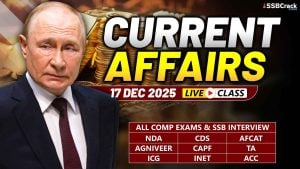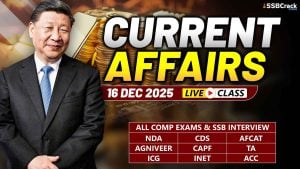Hindustan Aeronautics Limited’s Light Combat Helicopters deployed for operations at Leh
- The Hindustan Aeronautics Limited said on Wednesday two Light Combat Helicopters (LCH) produced by it have been deployed for operations at high altitude (Leh sector) at short notice to support IAF missions, “in the light of the prevailing situation on the border.” “It is the lightest attack helicopter in the world designed and developed by HAL to meet the specific and unique requirements of Indian Armed Forces reflecting the crucial role of HAL in ‘Atmanirbhar Bharat’, HAL’s CMD, R Madhavan, said.
- The Vice Chief of Air Staff, Air Marshal Harjit Singh Arora took part in one such operation along with HAL test pilot, Wing Cdr (Retd), Subash P John recently by taking-off from high altitude location to a forward area for a simulated attack on a high altitude target, the Bengaluru- headquartered company said in a statement.
- “This was followed by a landing at one of the most treacherous helipads in the region. The LCH successfully demonstrated its quick deployment prowess to forward locations in extreme temperatures,” it said.
- LCH is a potent weapon platform because of its state-of-the-art systems and highly accurate weapons that are capable of hitting any type of target by day or night, according to HAL. The other features of LCH include its ability to operate in the complete Area of Responsibility (AOR) and altitudes. It has capability to carry adequate weapon load at high altitudes under varied conditions. All these characteristics make it most suitable for hot and high-altitude operations, the statement added.
- The IAF and the Indian Army together need around 160 LCHs, HAL said. The Defence Acquisition Council (DAC) had approved the proposal for initial batch of 15 LCHs, the statement said.
- The IAF issued Request for Proposal (RFP) for 15 Limited Series Production (LSP) helicopter (10 for IAF and 5 for Army) and HAL had submitted its response, it said, adding, technical evaluation and the price negotiations have been concluded and the order is expected shortly. “However, as a proactive measure, HAL has launched production of LSPs in anticipation of orders at its Bengaluru facility,” the statement said.
Indian envoy to China Vikram Misri meets top party functionary to discuss LAC tensions
- Indian Ambassador to China Vikram Misri on Wednesday met Liu Jianchaou, the deputy director office of the CPC Central Committee Foreign Affairs Commission to discuss current tensions along LAC.
- During the meeting, Misri referred to India’s position on the situation on the borders on easter Ladakh and the overall bilateral relations, sources said. This comes within three days of last military talks.
- Major general-level talks held between India and China Sunday over the tensions in the Depsang Plains region along the Line of Actual Control (LAC) achieved no progress.
- There has not been any significant change in the ground situation in Ladakh, where the Chinese continue to occupy areas near Pangong Tso, and block Indian patrols in the Depsang Plains.
- Then ongoing talks between India and China have hit a roadblock, with the Chinese standing firm on their positions.
- India has told China to stop further construction and pull back troops from the Depsang-Daulat Beg Oldie sector of eastern Ladakh. During the talks between the two sides, India also told China to stop further construction activities in the area.
Skyroot – India’s first private company to test upper-stage rocket engine
- Aerospace start-up Skyroot Aerospace has successfully test fired an upper-stage rocket engine, becoming the first Indian private company to demonstrate the capability to build a homegrown rocket engine.
- The 3-D printed rocket engine – Raman, named after Nobel laureate CV Raman – has fewer moving parts and weighs less than half of conventional rocket engines with a similar capacity.
- The Hyderabad-headquartered firm, backed by CureFit founders Mukesh Bansal and Ankit Nagori, and Solar Industries, claimed that the engine was capable of multiple restarts, enabling the launch vehicle to insert various satellites into multiple orbits in a single mission. It will conduct more tests of the Raman engine over the next six months.
- Founded by Pawan Kumar Chandana and Naga Bharath Daka, both former scientists at the Indian Space Research Organisation (ISRO), Skyroot plans to build a family of rockets. The first rocket, which can hurl satellites of 250-700 kgs into a lower earth orbit, is expected to be launched by end-2021.
- “We demonstrated India’s first 100% 3D-printed bi-propellant liquid rocket engine injector. Compared to traditional manufacturing, this reduced the overall mass by 50%, reduced the total number of components and lead time by 80%,” Chandana said.
- The company has designed in-house software for launch vehicle guidance, navigation, and control functions, and is testing onboard its avionics modules.
- Skyroot had so far raised 31.5 crore from investors to develop a family of rockets named after Vikram Sarabhai, the founder of India’s space programme, with the capability to launch 250-700 kg satellites into low-earth orbit. The space start-up is now in talks to raise 90 crore by mid-2021.
- Over the years, India has emerged a global hub to launch small satellites using the polar satellite launch vehicles (PSLV).
- As the country opens its space sector to private players, start-ups such as Skyroot, Agnikul and Bellatrix are building small launchers, with 3-D printed engines, hoping to bring down the cost of launching satellites and capturing a bigger pie of the global small satellite launch market.
- Research firm Frost & Sullivan expects more than 10,000 small satellites to be launched globally in the next decade.
- V Gnanagandhi, another former ISRO scientist and a senior vice president at Skyroot, who is leading its liquid-propulsion team, said: “This test has qualified a unique monolithic design of injector with complex internal channels and demonstrated high performance for hypergolic rocket propellants.”
Ordnance Factory Tiruchirappalli launches Stabilized Remote-Controlled Gun
- The Ordnance Factory of Tiruchirappalli (OFT) has launched an indigenously manufactured weapon named stabilized remote-controlled gun (SRCG).
- A dedicated assembly and testing facility were also opened for manufacturing the weapon. Defence minister Rajnath Singh launched the weapon through video-conferencing on Monday as part of Atma Nirbhar Bharat Abhiyan (self-reliant India mission).
- OFT officials said the SRCG fitted with 12.7mm M2 NATO standard machine gun, is designed for marine applications.
- It will be mounted on warships and patrol boats and can remotely engage small boats, skiff, and other small crafts with high accuracy both during day and night.
- “Equipped with sensors, the weapon has an automatic target tracking capacity. The gun can be fired manually even in case of malfunction,” C Ariya Sakthi, works manager at OFT told.
- At an estimated cost of Rs 2.8 crore, the assembly and testing facility produces the weapon for Indian Navy and Coast Guard.
- The indigenous manufacturing will save Rs 167 crore, officials said. The new weapon will provide a business opportunity for Rs 255 crore per annum for the next four years to OFT and other sister factories. While the gun will be manufactured in Trichy, a contract is placed by integrated headquarters, ministry of defence on Elbit Systems, Israel for transfer of technology (ToT) for SRCG.
Pakistan Gives Illegal Gold, Uranium Mining Contracts to China in India’s Gilgit Baltistan Territory
- Pakistan, in violation of international laws and defiance of its own Constitution, has given a free hand to Chinese mining companies to plunder natural resources in the occupied Gilgit Baltistan (GB) area. Not only that, Islamabad has also signed a multi-billion-dollar contract with Beijing to build a mega dam in the Diamer division, an area that legally belongs to India.
- Over 2,000 leases for mining of gold, uranium and molybdenum have been illegally awarded to Chinese firms by the Pakistan government in Gilgit and Baltistan, also known as Northern Areas.
- The Imran Khan government has thrown environmental norms to the wind while allotting these illegal mining contracts revealed Nasir Aziz Khan, exiled leader, and Chief Spokesperson of United Kashmir People’s National Party (UKPNP), a prominent political outfit of GB area.
- “We will expose Pakistan’s conspiracy to plunder natural resources in the forthcoming convention of the United Nations in Geneva, next month,” Aziz told a major news agency over phone.
- “Rules are being blatantly flouted. The media cannot report. People who raise voice in GB are being punished. In such given circumstances when no one can oppose any decision, natural resources are being looted. Pakistan is playing into the hands of China,” Aziz said.
- “Local people are not consulted. Their interests have been totally ignored. The move to oblige China in the GB area also violates international laws,” the UKPMP leader who lives in Geneva, Switzerland added.
- In Northern Areas, which include three divisions, Gilgit, Baltistan and Diamer, the media is literally censored by the federal government. “In this part of the world (GB area), the press is controlled by the Pak government. A few local newspapers which are printed outside are checked and monitored by the agencies in Rawalpindi and Islamabad.
- “Consequently huge dams are being blatantly constructed. Precious mines, minerals and other resources are being plundered. The entire area is under the influence of China. In lieu of giving military support to Pakistan, the Chinese are looting our land and its rich resources,” said the exiled leader of UKPNP.
- Recently a Rs 442-billion joint venture was inked between a Chinese state-run firm and a commercial wing of Pakistan’s military to construct the mega Diamer Bhasha Dam.
- While natural resources of GB would be used to generate 45,000 MW of electricity, the end users would be largely the people of Pakistan living outside Northern Areas.
- Although there is a provincial assembly in GB, the government is virtually run by the Governor at the behest of Islamabad. Last year the leader of opposition in GB Assembly raised the issue of plundering of natural resources like uranium and gold by Chinese companies but such voices of dissent were silenced. The issue was given no coverage even in the national media.
Greece Armed Forces on alert as tensions with Turkey heat up
- Greece’s Armed Forces were placed in a state of absolute readiness after the Turkish navy performed maritime exercises off the island of Rhodes as Ankara’s research ship the Oruc Reis continues its oil exploration.
- Hellenic Navy and Air Force deployed in the wider sea area near Turkish warship formation, Greek newspaper Kathimerini said.
- According to media reports, Turkey has sent the military ships and Oruc Reis to begin a survey in the disputed area of the eastern Mediterranean.
- Currently, Oruc Reis remains in the Greece shelf.
- Ankara says that it is conducting a survey while Greece insists that such a survey is blocked by the noise of warships engaged in the area.
- Also reports that Hellenic Navy warships have lined up against Turkey warships accompanying research vessel Oruc Reis, both Greece and Turkey have ISTAR (intelligence, surveillance, target acquisition, and reconnaissance) assets airborne at this time.
- The area of the eastern Mediterranean may have rich reserves of hydrocarbons and Turkey is eager to exploit them. Turkish movements to investigate these hydrocarbon reserves has antagonized Athens.
#Independence_Day_Special_Coverage – INS Vikramaditya
- INS Vikramaditya is the newest and largest ship to join Indian Navy on 16 Nov 2013. The ship was commissioned on 16 Nov 13 by Defence Minister Shri AK Antony in Russia.
Background
- At the time of attaining our Independence our visionary leaders saw the centrality of a powerful Navy and set us on the right course by envisaging an Indian Navy centred on aircraft carriers for sea control in our expansive areas of maritime interest. INS Vikrant, India’s first aircraft carrier was acquired from Great Britain and commissioned on 04 Mar 1961.
- INS Vikrant was a Majestic class CATOBAR (Catapult Assisted Take Off but Arrested Recovery) carrier and operated Sea Hawk fighters, Alize (Anti-Submarine Warfare) aircraft and Seaking helicopters. Consistent with its vision, India next acquired HMS Hermes, a Centaur class STOVL carrier and a veteran of the Falkland War.
- INS Viraat was commissioned on 12 May 1987 as India’s second aircraft carrier and India’s first STOVL carrier operating the Sea Harrier aircraft. Soon after the acquisition of INS Viraat, INS Vikrant was also converted from a CATOBAR carrier to a STOVL (Short Take-off and Vertical Landing) carrier.
- INS Vikrant was decommissioned on 31 Jan 1997, after 36 years of glorious service under the Indian ensign. For almost a decade India had two aircraft carriers and the Indian Navy was fully cognisant of the criticality of having an aircraft carrier available for deployment on each seaboard to fulfil the Navy’s assigned tasks. In recognition of the importance of aircraft carriers, the Indian Navy had already started exploring the possibility of indigenously designing and constructing an Aircraft Carrier, this project took off in right earnest in the late 90s as the Air Defence Ship was conceived. However, given the long gestation period of such projects, the search for a replacement for INS Vikrant gained momentum as its decommissioning drew closer.
- It was at this juncture that Russia offered Admiral Gorshkov to the Indian Navy. Negotiations over acquiring the 44,500-ton Admiral Gorshkov started in 1994. Various high-level delegations who had assessed the ship had independently concluded that the ship’s hull was in good material state and would be worth considering for exploitation in the Indian Navy with a suitable mix of aircraft.
Signing of the Contract
- After detailed negotiations, the two countries signed a memorandum of understanding in Dec 1998 during a visit by Russian PM Yevgeny Primakov. The Inter-Governmental Agreement which included acquisition of Project 11430 (Admiral Gorshkov) was signed between the Federation of Russia and the Union Government of India on 04 Oct 2000.
- After a Detailed Project Development Review, contractual negotiations and thereafter price negotiations, Government approved the acquisition on 17 Jan 04 at a cost of Rs 4881.67 Cr for the complete package of R&R of the ship, spares, infrastructure augmentation and documentation. The deal was signed on 20 Jan 04 and the effective date of the contract was established as 24 Feb 04. The R&R of the ship commenced from 09 Apr 04.
- The repair and refit was being undertaken by FSUE Sevmash, the state-owned shipyard at Severodvinsk, Russia. The R&R was scheduled to have been completed within 52 months. Though the refurbishment process was started in right earnest, soon it was realized that the work and equipment requiring replacement was significantly higher than originally estimated. Entire length of cable, large portions of steel hull, motors, turbines, and boilers, etc. would have to be completely replaced with resulting in cost escalation and time slippage.
- A protracted renegotiation for arriving at a mutually acceptable price for refurbishment was held in the ensuing months. Finally, in Dec 2009, the Indian and the Russian sides arrived at an agreement on the final price of delivery of this ship. More significantly, it was agreed that the delivery of the ship would take place only in the year 2012. Though the re-negotiated price was significantly higher than what was originally agreed upon, the fillip that the addition of Gorshkov would give to the Blue water requirements of Indian Navy compensated the greater price.
- The journey of ‘Vikramaditya’ began as the Kiev class aircraft carrying cruiser ‘Baku’. Developed from the Moskva class helicopter carrying guided missile cruisers the Kiev class was a pioneering Soviet era design, featuring a flight deck arrangement capable of operating fixed wing VTOL fighters for the first time in the Soviet Navy. Baku was constructed by Chernomorsky Ship Building Enterprise, Nikolayev (now in Ukraine). About 400 enterprises and nearly 1,500 – 2,000 workers from different republics of USSR took part in building of the ship. The ship was commissioned on 20 Dec 1987. Conceived as an armed cruiser, Baku was heavily armed with twelve Anti-Ship Missile launchers, ten-gun mounts of differing calibre and rocket launchers and depth charges. The air element comprised Yak-38 aircraft
- ‘Baku’ was envisioned to be a full-fledged aircraft carrier by Admiral SG Gorshkov, however, due to conflicting dynamics at that time, the ship turned out as the last ‘compromise’ ship of the Kiev series. After her development and construction, it became clear to the Soviet leadership that the vision of Admiral Gorshkov of a classical aircraft carrier with ship borne aircraft as the primary weapons was indeed the most logical way ahead to develop the surface forces. On 07 Nov 1990, the ship was named after Admiral Sergey Georgiyevich Gorshkov.
- Baku/Admiral Gorshkov began its active operational service with the Northern Fleet and was deployed in the Mediterranean Sea and remained in active service till 1992 and thereafter continued in service albeit with limited operational deployments. The ship was finally decommissioned in 1996.
The Transformation – Project 11430
- Admiral Gorshkov was put in hibernation after her last sailing in 1995. With most of her equipment lying un-utilised since then, the task of breathing life and converting her from a VTOL (Vertical Take-off and Landing) missile cruiser carrier to a STOBAR aircraft carrier involved substantial degutting, equipment removal, refit and re-equipping. The major works envisaged were modification of flight deck to include ski-jump and arrester gear; modification of bulbous bow, aft aircraft lift & ammunition lifts; modification of 1750 out of 2500 compartments; installation of new main boilers; installation of new and additional Diesel Generators; replacement of existing distilling plants; fitment of Reverse Osmosis plants, new AC plants and Refrigeration plants and installation of new sensors and equipment. In 2007, as the refit and repair of the ship was in progress, the yard realized that the scope of work was much larger than initially estimated and so a revised timeline for completion of the task of modernization was agreed upon by both Russian and Indian sides. With a revised timeline the delivery of ship was expected by end 2012.
Overall Power
- A total of 234 new hull sections were fabricated using 2500 tonnes of steel which is almost equivalent to the standard displacement of a mid-size frigate. Repair and re-equipping of Vikramaditya to give a new lease of life as a full- fledged carrier was no mean task and was probably as demanding a task as constructing a similar tonnage ship from the drawing board. The task was enabled by the expertise and experience of the Russian designers and yard workers working hand in glove with Indian experts. The extreme cold weather conditions of winter only made the work environment harder. At the end of this refit, spanning a little short of a decade, Vikramaditya has metamorphosed into a fully capable and potent platform.
- An aircraft carrier carrying potent long-range multi-role fighters is a platform inherently deigned for power projection. In as much as ‘Gorshkov’ was transformed to create ‘Vikramaditya’, so also Vikramaditya will transform the face of the Fleet Air Arm of the Indian Navy.
- STOBAR Carrier
- Displacement : 44,500 T
- Length OA : 284 m
- Maximum Beam : 60 m
- Speed : over 30 kts
- 04 propellers
- powered by 08 Boilers,
- Aircraft component : MiG 29K, Kamov 31, Kamov 28, Seaking, ALH, Chetak
- Vikramaditya, the floating airfield has an overall length of about 284 meters and a maximum beam of about 60 meters, stretching as much as three football fields put together. Standing about 20 storeys tall from keel to the highest point, the sheer sight of this 44,500 tonnes mega structure of steel is awe inspiring. The ship has a total of 22 decks.
- With over 1,600 personnel on board, Vikramaditya is literally a ‘Floating City’. Associated with this large population is a mammoth logistics requirement – nearly a lakh of eggs, 20,000 litres of milk and 16 tonnes of rice per month. With her complete stock of provisions, she is capable of sustaining herself at sea for a period of about 45 days. With a capacity of over 8,000 tonnes of LSHSD, she is capable of operations up to a range of over 7,000 nautical miles or 13000 kms.
- To enable this 44,500 tonnes floating steel city to cut through the choppy seas with speeds of up to 30 knots, she is powered by 08 new generation boilers of steam capacity of 100 TPH at an exceedingly high pressure of 64 bars, generating a total output power of 180,000 SHP. Vikramaditya heralds in a new generation of boiler technology with a remarkably high level of automation. These high pressure and highly efficient boilers power four enormous propellers, each greater in diameter than twice the height of an average male. Such a four propeller – four shaft configuration is another first in the Indian Navy.
- The 06 turbo alternators and 06 diesel alternators onboard generate a total electricity of 18 megawatts to power various equipment of the ship, enough to cater to the lighting requirement of a mini city. The ship also houses 02 Reverse Osmosis plants providing an uninterrupted supply of 400 Tons per day of fresh water.
- An extensive revamp of sensors including fitment of Long-range Air Surveillance Radars, Advanced Electronic Warfare Suite makes the ship capable of maintaining a surveillance bubble of over 500 kms around the ship.
- The ship has the ability to carry over 30 aircraft comprising an assortment of MiG 29K/Sea Harrier, Kamov 31, Kamov 28, Sea King, ALH-Dhruv and Chetak helicopters. The MiG 29K swing role fighter is the main offensive platform and provides a quantum jump for the Indian Navy’s maritime strike capability. These fourth-generation air superiority fighters provide a significant fillip for the Indian Navy with a range of over 700 nm (extendable to over 1,900 nm with inflight refuelling) and an array of weapons including anti-ship missiles, Beyond Visual Range air-to-air missiles, guided bombs, and rockets.
- The ship is equipped with state-of-the-art launch and recovery systems along with aids to enable smooth and efficient operation of ship borne aircraft. Major systems include the LUNA Landing system for MiGs, DAPS Landing system for Sea Harriers and Flight deck lighting systems.
- The heart of the operational network that infuses life into the combat systems onboard the ship is the Computer aided Action Information Organisation (CAIO) system, LESORUB-E. LESORUB has the capability to gather data from ship’s sensors and data links and to process, collate and assemble comprehensive tactical pictures. This state-of-the-art system has been specifically designed keeping in mind the essential requirement on the carrier for fighter control and direction.
- One of the most prominent equipment fitted on the super structure is the Resistor-E radar complex. Resistor-E is the automated system designed for providing air traffic control, approach/landing and short-range navigation for ship borne aircraft. This complex along with its various sub-systems provides navigation and flight data to ship borne aircraft operating at extended ranges from the mother ship. The precision approach guidance system aids the fighters on approach to be directed down to a distance of 30 meters short of flight deck. Vikramaditya also boasts of a very modern communication complex, CCS MK II, to meet her external communication requirement. Installation of Link II tactical data system allows her to be fully integrated with the Indian Navy’s network centric operations.
REVIEW QUESTIONS
- Indian envoy to China:
- Gourangalal Das
- Vikram Misri
- Taranjit Singh Sandhu
- Vikas Swarup
ANSWER: B
- India’s first private company to test upper-stage rocket engine:
- Agnikul Cosmos
- Bellatrix Aerospace
- Skyroot Aerospace
- Pixxel
ANSWER: C
- Which Ordinance Factory has launched an indigenously manufactured weapon named stabilized remote-controlled gun (SRCG)?
- Ordinance Factory Medak (OFM)
- Ordinance Factory Tiruchirappalli (OFT)
- Ordinance Factory Jabalpur (OFJ)
- Ordinance Factory Kanpur (OFK)
ANSWER: B
- Hellenic Navy is the naval force of:
- Turkey
- Israel
- Libya
- Greece
ANSWER: D
- Recently a Rs 442-billion joint venture was inked between a Chinese state-run firm and a commercial wing of Pakistan’s military to construct what dam?
- Tarbela Dam
- Rawal Dam
- Diamer Bhasha Dam
- Mangla Dam
ANSWER: C



















